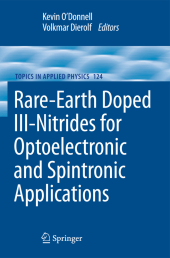 Neuerscheinungen 2014Stand: 2020-02-01 |
Schnellsuche
ISBN/Stichwort/Autor
|
Herderstraße 10
10625 Berlin
Tel.: 030 315 714 16
Fax 030 315 714 14
info@buchspektrum.de |

Volkmar Dierolf, Kevin Peter OŽDonnell
(Beteiligte)
Rare-Earth Doped III-Nitrides for Optoelectronic and Spintronic Applications
Herausgegeben von OŽDonnell, Kevin Peter; Dierolf, Volkmar
2010. 2014. xvi, 355 S. 20 Tabellen. 235 mm
Verlag/Jahr: SPRINGER NETHERLANDS 2014
ISBN: 9401784728 (9401784728)
Neue ISBN: 978-9401784726 (9789401784726)
Preis und Lieferzeit: Bitte klicken
This book summarises recent progress in the science and technology of rare-earth doped nitrides, providing a snapshot of the field at a critical point in its development. It is the first book on rare-earth doped III-Nitrides and semiconductors.
It has been noted several times previously that the Rare Earths (RE), a sequence of elements with atomic numbers in the range from 58 (Ce) to 71 (Lu), are neither earths nor particularly rare. They are metals, whose ores are often found together with oxides of the alkaline earths (Ca, Mg), staples of the building industry, th while Cerium, for example, is the 25 most abundant element in the Earth s crust. However, the chemical similarity of all REs to each other and to Lanthanum, reflected in their alternative descriptor, Lanthanoids, made extraction of the separate elements difficult until technical advances in the 1960s kick-started the modern era of RE science. The most widespread commercial use of RE metals at present is in the prod- tion of super-strong permanent magnets, containing Neodymium: check your refrigerator door for an example. RE ferromagnetism arises from the angular momentum of electrons in partially filled 4f atomic shells. In chemical compounds of RE with non-metals, the 4f shell is surrounded by filled 5s and 5p orbitals, 1 2 while bonding involves the outerlying 5d and 6s electrons, resulting (usually) in 3+ 3+ a RE ion that is chemically similar to La . (RE may also be found in a divalent charge state, with an extra electron in the 5d shell. ) Hence the sequence of 3+ 3+ trivalent ions from Ce to Yb is characterised by a 4f shell occupation that rises from 1 to 13 electrons.
1.Introduction and overview. Kevin OŽDONNELL, Strathclyde, UK.
2.Theoretical background. Robert JONES, Exeter and Benjamin HOURAHINE, Strathclyde, UK.
3.In-situ doping of MBE III-N: RE epilayers. Andrew STECKL and John ZAVADA, Nanolab Cincinatti, USA.
4.RE implantation and annealing of III-Nitrides. Katharina LORENZ and Eduardo ALVEZ, ITN Lisbon, Portugal.
5.Lattice location studies of RE impurities in III-Nitrides. Andre VANTOMME, IKS Leuven, Belgium.
6.Microscopic characterisation of luminescent III-N:RE epilayers. Robert MARTIN, Strathclyde, UK
7.High-resolution optical studies of site multiplicity in III-N:RE. Volkmar DIEROLF, Lehigh, USA.
8.RE-doped III-N quantum dots. Bruno DAUDIN, Grenoble, France.
9.Excitation model for RE ions in solids. Alain BRAUD and Pierre RUTERANA, Caen, France.
10.III-N:RE electroluminescence. Andrew STECKL and John ZAVADA, Nanolab Cincinatti, USA.
11.RE-doped III-N for spintronics applications. Oliver BRANDT, PDI Berlin, Germany.
12.Summary and prospects for future work. Kevin OŽDONNELL, Strathclyde, UK.


